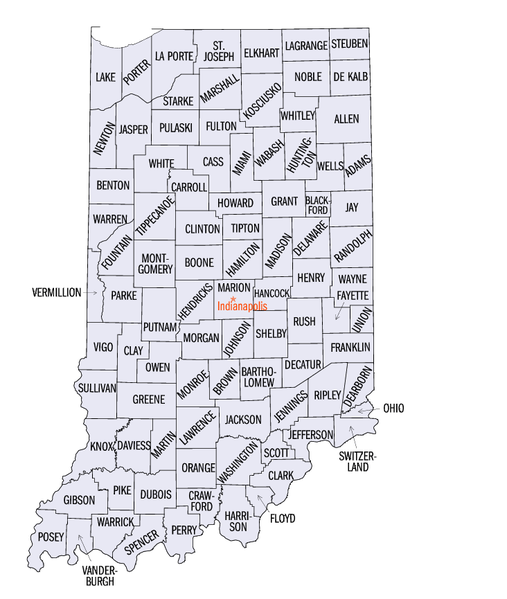Indiana RedistrictingRedistricting of state legislatures and the US House of Representatives is a high-profile, high-stakes process that every state engages in the year after the decennial census. What many people in Indiana—including many government officials—do not realize is that most local governments are also required by Indiana state law and the Equal Protection Clause of the US Constitution to redistrict. In the case of county councils and certain types of school boards in Indiana, that process had to be completed by the end of 2011.
We have found that a majority of county councils in Indiana either failed to redistrict in 2011, or failed to draw districts that are nearly equal in population, compact, and consist of whole precincts—all of which are required by law. Our preliminary conclusion is that many school boards that were required to redistrict in 2011 also failed to do so, or did so improperly. |
Electoral and Representational Equality
Underlying our system of representative democracy are two related concepts: “electoral equality”—that each person’s vote should count approximately the same as every other person’s vote, and “representational equality”—that each elected representative should represent approximately the same number of people.
Thus, the much-quoted idea of “one-person-one-vote” means much more than banning individual voters from voting more than once in the same election. It also means that the number of people represented by each member of a governmental body needs to be approximately equal. If one person on an elected body represents 1,000 people while another represents only 500, then the people in the more populous district are underrepresented.
In order to maintain approximate electoral and representational equality, all governmental bodies in the United States except the US Senate are required to redistrict every 10 years if the members of that body are elected to represent specific districts. Federal and state courts have consistently upheld this requirement as it applies to local governments. Yet the mandate to redistrict has been flouted for decades by Indiana local governments, with the acquiescence of state officials, including the Indiana Elections Division and the Indiana General Assembly.
Thus, the much-quoted idea of “one-person-one-vote” means much more than banning individual voters from voting more than once in the same election. It also means that the number of people represented by each member of a governmental body needs to be approximately equal. If one person on an elected body represents 1,000 people while another represents only 500, then the people in the more populous district are underrepresented.
In order to maintain approximate electoral and representational equality, all governmental bodies in the United States except the US Senate are required to redistrict every 10 years if the members of that body are elected to represent specific districts. Federal and state courts have consistently upheld this requirement as it applies to local governments. Yet the mandate to redistrict has been flouted for decades by Indiana local governments, with the acquiescence of state officials, including the Indiana Elections Division and the Indiana General Assembly.
How to use this website
This website reports research done by Professor Kelsey Kauffman and her students at DePauw University in 2011 and 2012. We created it to provide citizens and government officials detailed information that is available nowhere else on the success or failure of local governments in Indiana to redistrict after the 2010 census.
The “About” section explains the legal requirement that local governments redistrict and the rationale behind doing so. It provides two egregious examples of the failure to redistrict, the North Putnam School Board and the Bartholomew County Council, as well the apparent success story of municipal redistricting. It also considers why local and state government officials have shirked their duties when it comes to redistricting, the risks of doing so, and possible legislative remedies.
The “County Council” section provides detailed information and maps for 86 of Indiana’s 92 county councils. (Excluded are the state’s three largest counties—Lake, Marion, and St. Joseph’s—as their county councils operate under different rules, and Allen, Elkhart, and Gibson Counties due to problems with data and generating accurate maps.) For every county, we report whether its districts were in compliance before the 2010 census; whether it redistricted in 2011; and whether it is in compliance now, with districts that are nearly equal in population, compact, contiguous and contain only whole precincts.
We would like to give a special thank you to the following individuals for their help in this project:
The “About” section explains the legal requirement that local governments redistrict and the rationale behind doing so. It provides two egregious examples of the failure to redistrict, the North Putnam School Board and the Bartholomew County Council, as well the apparent success story of municipal redistricting. It also considers why local and state government officials have shirked their duties when it comes to redistricting, the risks of doing so, and possible legislative remedies.
The “County Council” section provides detailed information and maps for 86 of Indiana’s 92 county councils. (Excluded are the state’s three largest counties—Lake, Marion, and St. Joseph’s—as their county councils operate under different rules, and Allen, Elkhart, and Gibson Counties due to problems with data and generating accurate maps.) For every county, we report whether its districts were in compliance before the 2010 census; whether it redistricted in 2011; and whether it is in compliance now, with districts that are nearly equal in population, compact, contiguous and contain only whole precincts.
We would like to give a special thank you to the following individuals for their help in this project:
- Beth Wilkerson - GIS Specialist
- Greg Screws - GIS Intern
- Rob Crawley - DPU Printing Services
- Joe Smith - DPU Printing Services
- Kelsey Kauffman - Program Advisor
- Shelby Bremer - Student Intern
- Richard Walsh - Student Intern

